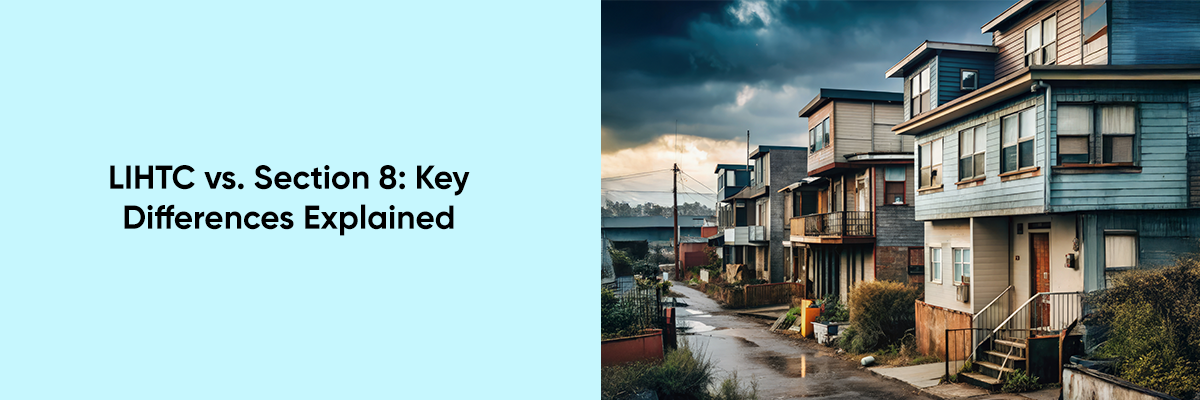The Low-Income Housing Tax Credit (LIHTC) program and the Section 8 program are two major federal initiatives aimed at making housing affordable for low-income households in the United States. While both programs share the common goal of housing assistance, they operate through fundamentally different mechanisms.
Understanding their key differences is crucial for anyone involved in affordable housing, from prospective tenants to developers and investors.



What is LIHTC?
The Low-Income Housing Tax Credit (LIHTC) program was established in 1986 as part of the Tax Reform Act to incentivize private investment in affordable rental housing. It does this by offering tax credits to developers who build or rehabilitate rental properties to provide affordable housing for low- and moderate-income households.
Here’s how LIHTC works:
- Tax Credits to Developers: LIHTC is essentially a tax incentive program. The government allocates tax credits to states, which in turn award these credits to developers and investors.
- Affordable Rent Levels: To qualify for LIHTC, a project must allocate a certain percentage of its units to low-income tenants.
- Long-Term Affordability: LIHTC requires that these properties remain affordable for at least 15 years.
- Income Qualification: LIHTC housing ensures that the rental rates remain affordable, but it does not provide rental assistance to cover the rent cost directly.
What is Section 8?
Section 8, also known as the Housing Choice Voucher Program, is a direct rental assistance program managed by the U.S. Department of Housing and Urban Development (HUD). Established in 1974, Section 8 is designed to help low-income families, the elderly, and individuals with disabilities afford decent, safe, and sanitary housing in the private market.
Key elements of the Section 8 program include:
- Tenant-Based Vouchers: The Section 8 program provides housing choice vouchers to eligible households. These vouchers allow tenants to rent homes from private landlords while the government covers a portion of the rent.
- Direct Subsidies: The voucher typically covers 70% of the tenant’s rent, with the tenant responsible for the remaining 30% of their income.
- Flexible Housing Options: Section 8 tenants can choose any rental unit that meets HUD’s standards, giving them flexibility in where they live.
Eligibility and Waiting Lists: Tenants must meet specific income qualifications. However, the demand for Section 8 assistance often exceeds available funding, leading to long waiting lists in many areas.
Understanding fair housing laws is essential for compliance and best practices in the housing industry. For in-depth insights and expert guidance, join our Fair Housing Webinars hosted by industry professionals.
Key Differences Between LIHTC and Section 8
While both LIHTC and Section 8 aim to make housing more accessible, their operational differences highlight distinct approaches to achieving this goal.
- Type of Assistance Provided
- LIHTC: Provides indirect subsidies to developers, ensuring rent affordability through tax credits. Tenants do not receive any direct rental assistance, but the units are rented at below-market rates.
- Section 8: Provides direct rental subsidies to tenants through vouchers. This helps tenants cover rent in any qualifying unit, making it an income-based support program.
- Eligibility Requirements
- LIHTC: Eligibility is determined by the income limits relative to the AMI, generally set at or below 60%. However, because it doesn’t cover part of the rent, tenants need a stable income to meet the rent requirements.
Learn more about how LIHTC rents are calculated, by reading our in-depth blog. - Section 8: Eligibility is based on household income, usually at or below 50% of the AMI. HUD’s preference often prioritizes the very low-income households who most need assistance. Section 8 applicants must undergo a background check and they should know how far back does the section 8 background check go.
- LIHTC: Eligibility is determined by the income limits relative to the AMI, generally set at or below 60%. However, because it doesn’t cover part of the rent, tenants need a stable income to meet the rent requirements.
- Flexibility in Housing Choice
- LIHTC: Tenants are restricted to LIHTC-approved properties, which means they must select housing from among designated affordable units within LIHTC developments.
- Section 8: Tenants can use their vouchers in the private rental market, giving them broader flexibility to find housing that meets their needs and lifestyle preferences, subject to landlord acceptance and HUD standards.
- Duration of Affordability
- LIHTC: Properties funded through LIHTC must remain affordable for a minimum of 15 years, with a common practice of extending this to 30 years. This long-term affordability benefits communities by increasing the availability of affordable units over time.
- Section 8: The subsidy is tied to the tenant rather than the property. When tenants leave, they can take their vouchers with them to another qualified property, which offers flexibility but does not necessarily increase the stock of affordable units over the long term.
- Administration and Availability
- LIHTC: Administered through state housing agencies that allocate credits to developers via a competitive application process. Once the units are built, they remain affordable, increasing the overall supply of affordable housing.
- Section 8: Managed by local public housing agencies (PHAs) with funding from HUD. Due to limited funding, many PHAs maintain long waiting lists, creating significant delays for applicants seeking assistance.
Conclusion
LIHTC and Section 8 each play vital roles in the landscape of affordable housing. LIHTC increases the supply of affordable housing through developer incentives, while Section 8 directly supports low-income households by subsidizing rent. Though each program has unique strengths and limitations, together they address different facets of the affordable housing crisis. By balancing supply-side and demand-side approaches, LIHTC and Section 8 contribute to a more accessible housing market for millions of Americans.


